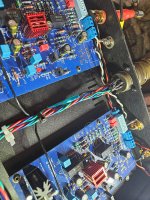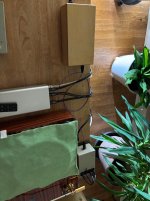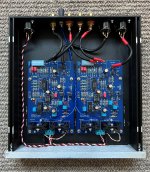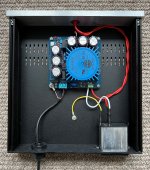Yes, done.
My turntable, preamp and power supplies are on a separate rack, about 6 feet from the amps. That's why I need longer balanced cables.
I got the P3 signal box close to its power supply box and the Lingo, but I don't hear any noise -with the default op amps. I think I can move things around a bit to put two or three feet from the signal box to the power supply boxes. That's as far as I can.
But in some ways, since I hear no noise from the default op amps in the current configuration, I wonder if I should let it be to see if other op amps are susceptible?
My turntable, preamp and power supplies are on a separate rack, about 6 feet from the amps. That's why I need longer balanced cables.
I got the P3 signal box close to its power supply box and the Lingo, but I don't hear any noise -with the default op amps. I think I can move things around a bit to put two or three feet from the signal box to the power supply boxes. That's as far as I can.
But in some ways, since I hear no noise from the default op amps in the current configuration, I wonder if I should let it be to see if other op amps are susceptible?
@tonyEE Am taking a slightly different approach as shown in the (disappointing result) Sparkos review above. Want to have a base against which to measure and the 2068D stock opamp serves for that. Then I select a set of 3 analog pressing -- classical, jazz, and pop -- and listen to all three with one opamp then again with the comparison opamp. During listening, concentrate on elements of noise, dynamics, soundstage, presence, etc. Then the differences are noted separating factual statements and taste assessments.
Will be doing this with the Burson 7 Vivid Pro this weekend and you will see the result.
What has been particularly interesting to me is that the P3's sound changes so much with opamp choice. The Sparkos discrete opamp, for instance, had a much poorer dynamic range than the 2068. Would not have expected the opamp to cause this kind of a difference.
And watch out! (LOL) Opamp rolling generates strong feelings from the thread participants!
Am fortunate, btw, in that my system is largely DIY and is completely free of noise and extraordinarily transparent.
Will be doing this with the Burson 7 Vivid Pro this weekend and you will see the result.
What has been particularly interesting to me is that the P3's sound changes so much with opamp choice. The Sparkos discrete opamp, for instance, had a much poorer dynamic range than the 2068. Would not have expected the opamp to cause this kind of a difference.
And watch out! (LOL) Opamp rolling generates strong feelings from the thread participants!
Am fortunate, btw, in that my system is largely DIY and is completely free of noise and extraordinarily transparent.
I got something like 10 or 12 opamps already lined up. If i did an A to B I'd be at this full time -and I got a job...
Yes, my set up, outside of the sources ( TT and DAC ) and speakers is now totally DIY. Truly quiet background, I think that's important and the reason why I figured I could do the op amp rolling comparison. The P3 version 1 ( prototype ) had a very little bit of background noise in one channel, the current one is noise free. This is also part of going to full balanced configuration and no tube preamp... to lower the noise as much as possible.
Strong feelings? ROTFLOL... Story of my life. Just ask those guys with direct drive turntables.
Oh, BTW, you will also notice that my testing will be done with a BELT DRIVEN TURNTABLE.... and a STRAIGHT TONEARM.... none of that direct drive with a curved thingie on it. I want the notes to travel directly and not be subject to the resonant electromechanical plasma created by a DD with a bent tonearm.
Yes, my set up, outside of the sources ( TT and DAC ) and speakers is now totally DIY. Truly quiet background, I think that's important and the reason why I figured I could do the op amp rolling comparison. The P3 version 1 ( prototype ) had a very little bit of background noise in one channel, the current one is noise free. This is also part of going to full balanced configuration and no tube preamp... to lower the noise as much as possible.
Strong feelings? ROTFLOL... Story of my life. Just ask those guys with direct drive turntables.
Oh, BTW, you will also notice that my testing will be done with a BELT DRIVEN TURNTABLE.... and a STRAIGHT TONEARM.... none of that direct drive with a curved thingie on it. I want the notes to travel directly and not be subject to the resonant electromechanical plasma created by a DD with a bent tonearm.
maybe if you want to avoid buzzing you should cut back on the espresso.
(buzz buzz buzz go the honeybees... )
(buzz buzz buzz go the honeybees... )
🤣 🤣 🤣 🤣(buzz buzz buzz go the honeybees... )
You guys are convincing me to take another maybe more serious and lengthy approach at yeat another opamp-swap.
Now I´m just waiting for the "mood".
Most of those I´ve picked are low cost, just to see if there should be some secret revelation buried somewhere.
So.... to a start I´ve picked these:
🤣 🤣 🤣Many years ago there was a Brown Dog shoe company in St. Louis. Didn't know they also made opamps...
As Mark stated. Google the company "Cimarron Technology".
maybe if you want to avoid buzzing you should cut back on the espresso.
(buzz buzz buzz go the honeybees... )
Actually the espresso is not the issue. I usually drink two double shots daily... noon and four o'clock. Feels good. My blood pressure is normal.
Ever used a mocha pot? You know, I got this "10 cup" pot... well, it holds like 18oz or so... you know... two normal North American Cups.
You wanna fly? You wanna drink coffee that requires you to use a TCAS receiver? Just go drink two "cups" from a mocha pot.
Bzz.... zing! ZIIIINNNNG!
The Burson 7 Vivid Pro Duals arrived this morning and have been initially tested (see the obligatory jpeg below -- at 19mm high they will fit into Gianluca's chassis). Have described my analytical method above and add here the 3 analog recordings used:
1. Copland: “El Salon Mexico,” Columbia MG 30071
2. “Tranes Blues” from “Workin' with the Miles Davis Quintet,” Prestige CR00608
3. “All that You Dream” from “Living in the USA” (Ronstadt) Asylum 6E-155
Finished the preview with the stock 2068D then played the same 3 with the Vivid. First reaction was “they sound very alike.” Then, as the session continued noticed three significant differences. First, Vivid's soundstage was extremely accurate with the soloist more firmly planted between the speakers than I had ever heard and side/FB positions very stable and accurate. Second, individual voices/instruments did not have the sharp edge of the 2068 (good or bad depending upon your taste) but were, instead, integrated into the overall ensemble more naturally. Third (and this is the big one) the bass was very realistic: excellent timbre and subtle moves by the great Paul Chambers (“Workin”) were heard with power and ease.
Intrigued by this excellence in the bass region I brought out some of the vinyl I use to check bass response. First Beethoven's 5th Symphony, 3rd movement. The tempo change in this scherzo begins with a rapid double bass line that is hard to play, record, and hear clearly. Using Ashkenazy's London recording (LDR 72015) the sound was perfect for the DB section – something I had not heard before in the vinyl world. Powerful goosebumps here. So good, had to listen to the fourth movement as well.
Then I checked the overall timbre with Ashkenazy's Beethoven: Five Piano Concertos (London R215010). Very accurate and the soloist positioning in the soundstage was to the left of the conductor, in front, exactly where he should be (and first time I had heard the correct placement). String sections were, as well, rock solid and placed well.
Good news, here. The Vivid has already replaced my long-used 2068D and will be enjoying its excellence in the future. It is rather expensive (around $170) and you will decide whether the above characteristics are worth that price for your system. If you prize bass response and have a system that can grunt well in the 30-50 hz range, you should check them out.
1. Copland: “El Salon Mexico,” Columbia MG 30071
2. “Tranes Blues” from “Workin' with the Miles Davis Quintet,” Prestige CR00608
3. “All that You Dream” from “Living in the USA” (Ronstadt) Asylum 6E-155
Finished the preview with the stock 2068D then played the same 3 with the Vivid. First reaction was “they sound very alike.” Then, as the session continued noticed three significant differences. First, Vivid's soundstage was extremely accurate with the soloist more firmly planted between the speakers than I had ever heard and side/FB positions very stable and accurate. Second, individual voices/instruments did not have the sharp edge of the 2068 (good or bad depending upon your taste) but were, instead, integrated into the overall ensemble more naturally. Third (and this is the big one) the bass was very realistic: excellent timbre and subtle moves by the great Paul Chambers (“Workin”) were heard with power and ease.
Intrigued by this excellence in the bass region I brought out some of the vinyl I use to check bass response. First Beethoven's 5th Symphony, 3rd movement. The tempo change in this scherzo begins with a rapid double bass line that is hard to play, record, and hear clearly. Using Ashkenazy's London recording (LDR 72015) the sound was perfect for the DB section – something I had not heard before in the vinyl world. Powerful goosebumps here. So good, had to listen to the fourth movement as well.
Then I checked the overall timbre with Ashkenazy's Beethoven: Five Piano Concertos (London R215010). Very accurate and the soloist positioning in the soundstage was to the left of the conductor, in front, exactly where he should be (and first time I had heard the correct placement). String sections were, as well, rock solid and placed well.
Good news, here. The Vivid has already replaced my long-used 2068D and will be enjoying its excellence in the future. It is rather expensive (around $170) and you will decide whether the above characteristics are worth that price for your system. If you prize bass response and have a system that can grunt well in the 30-50 hz range, you should check them out.
Attachments
I'm running the V7 Vivids in the DAC ( 2 duals, 2 singles ), they replaced the V6 Vivids.
They really sound very good in there as well. Excellent sense of rhythm and placement.
The V7s are also shorter than the V5 and V6.
My balanced cable might now be here AFTER Christmas... WTH?
I'm not taking the V7s out of the DAC... so I guess I'll be buying more.
They really sound very good in there as well. Excellent sense of rhythm and placement.
The V7s are also shorter than the V5 and V6.
My balanced cable might now be here AFTER Christmas... WTH?
I'm not taking the V7s out of the DAC... so I guess I'll be buying more.
Last edited:
The Burson 7 Vivid Pro Duals arrived this morning and have been initially tested (see the obligatory jpeg below -- at 19mm high they will fit into Gianluca's chassis). Have described my analytical method above and add here the 3 analog recordings used:
1. Copland: “El Salon Mexico,” Columbia MG 30071
2. “Tranes Blues” from “Workin' with the Miles Davis Quintet,” Prestige CR00608
3. “All that You Dream” from “Living in the USA” (Ronstadt) Asylum 6E-155
Finished the preview with the stock 2068D then played the same 3 with the Vivid. First reaction was “they sound very alike.” Then, as the session continued noticed three significant differences. First, Vivid's soundstage was extremely accurate with the soloist more firmly planted between the speakers than I had ever heard and side/FB positions very stable and accurate. Second, individual voices/instruments did not have the sharp edge of the 2068 (good or bad depending upon your taste) but were, instead, integrated into the overall ensemble more naturally. Third (and this is the big one) the bass was very realistic: excellent timbre and subtle moves by the great Paul Chambers (“Workin”) were heard with power and ease.
Intrigued by this excellence in the bass region I brought out some of the vinyl I use to check bass response. First Beethoven's 5th Symphony, 3rd movement. The tempo change in this scherzo begins with a rapid double bass line that is hard to play, record, and hear clearly. Using Ashkenazy's London recording (LDR 72015) the sound was perfect for the DB section – something I had not heard before in the vinyl world. Powerful goosebumps here. So good, had to listen to the fourth movement as well.
Then I checked the overall timbre with Ashkenazy's Beethoven: Five Piano Concertos (London R215010). Very accurate and the soloist positioning in the soundstage was to the left of the conductor, in front, exactly where he should be (and first time I had heard the correct placement). String sections were, as well, rock solid and placed well.
Good news, here. The Vivid has already replaced my long-used 2068D and will be enjoying its excellence in the future. It is rather expensive (around $170) and you will decide whether the above characteristics are worth that price for your system. If you prize bass response and have a system that can grunt well in the 30-50 hz range, you should check them out.
Could you please measure the height of the vivids when placed in the board? I am wondering if they would fit in my sandwiched arrangement of the boards.
@grataku
Just deflate the tires a little and proceed slowly...
Seriously, I asked before how the PCBs were attached to the acrylic... screw-to or bolt-on.
Maybe there's a way to mount the PCBs below the acrylic using very flat head fasteners. You might get the PCBs very close to the metal chassis. You could install a mylar sheet insulator to prevent shorts.
There might be a way to compress the assembly.
oops... I think that was aimed at a different project. Sorry.
Just deflate the tires a little and proceed slowly...
Seriously, I asked before how the PCBs were attached to the acrylic... screw-to or bolt-on.
Maybe there's a way to mount the PCBs below the acrylic using very flat head fasteners. You might get the PCBs very close to the metal chassis. You could install a mylar sheet insulator to prevent shorts.
There might be a way to compress the assembly.
oops... I think that was aimed at a different project. Sorry.
Last edited:
Just to clarify, im asking for the distance between the component side of the pcb to the tippy top of the vivid. Today I was busy with th power supply assembly and boxing. I now really like making small baltic birch boxes for these kinds of things. Tomorrow I will start playing with the opams swapping.
Attachments
Now I am curious. My project or someone elses'? 😉@grataku
Just deflate the tires a little and proceed slowly...
Seriously, I asked before how the PCBs were attached to the acrylic... screw-to or bolt-on.
Maybe there's a way to mount the PCBs below the acrylic using very flat head fasteners. You might get the PCBs very close to the metal chassis. You could install a mylar sheet insulator to prevent shorts.
There might be a way to compress the assembly.
oops... I think that was aimed at a different project. Sorry.
I think someone else's
must be
it was a chap who mounted his PCBs to an acrylic plate so he didn't have to drill into the bottom plate of the chassis. I'd asked him about the details and he never answered. your description made me remember... sort of.
hope your opamp fits.
I need a nap badly.
must be
it was a chap who mounted his PCBs to an acrylic plate so he didn't have to drill into the bottom plate of the chassis. I'd asked him about the details and he never answered. your description made me remember... sort of.
hope your opamp fits.
I need a nap badly.
- Home
- Amplifiers
- Pass Labs
- Pearl 3 Burning Amp 2023




